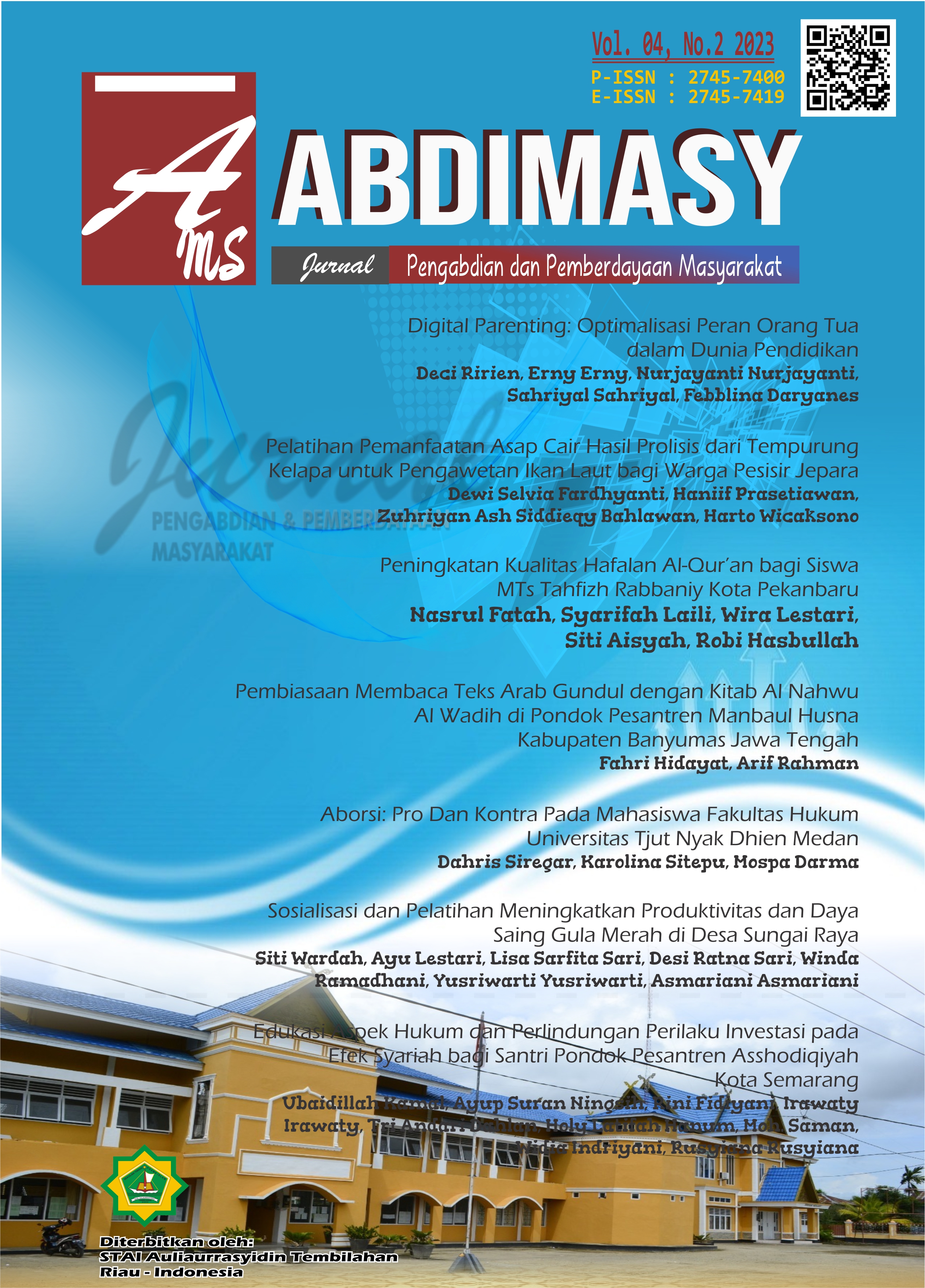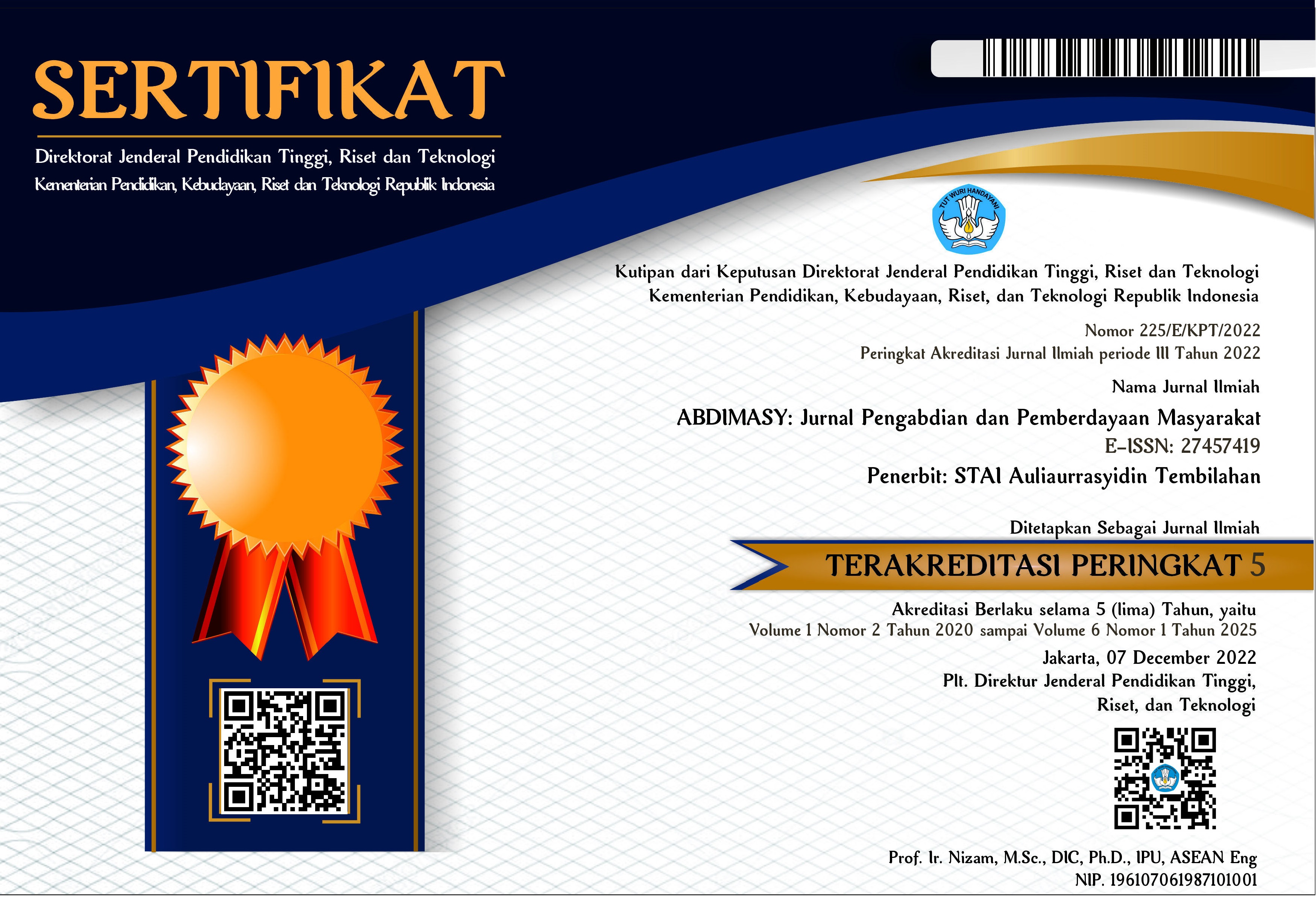Pelatihan Pemanfaatan Asap Cair Hasil Prolisis dari Tempurung Kelapa untuk Pengawetan Ikan Laut bagi Warga Pesisir Jepara
DOI:
https://doi.org/10.46963/ams.v4i2.1262Keywords:
Liquid smoke, Coconut shell, Pyrolysis, Preservation, FishermanAbstract
Pyrolysis which is a technology that might become a solution for fishermen in the Jepara Coastal Village. Fish caught by fishermen can be preserved using natural ingredients that are safe and healthy, namely liquid smoke so that the fish remains fresh and safe for consumption even if it is stored for up to 3 weeks. The purpose of this activity is to provide added value economically since the fishermen can maintain high selling prices, especially when the fish they catch are abundant. With a special target, fishermen can make this natural preservative from the main ingredient which is also abundantly available in Jepara, namely coconut shell. The method of applying Appropriate Technology is divided into several stages. (1) Initial outreach to the target community by identifying fishermen's needs in preserving fish; (2) Training and practice on the use and maintenance of this technology for the production of liquid smoke. This community service activity that is a transfer of knowledge provides understanding to fishermen to use liquid smoke as a fish preservative and avoid using hazardous materials such as formaldehyde and borax. Fishermen partners in Pesisir Jepara Village have experienced increased skills and knowledge on how to make liquid smoke and how to use it on caught fish obtained from the sea. This natural preservation provides economic benefits by delaying sales but the condition of the fish is still fresh and can be consumed properly.
Downloads
References
Abrina Anggraini, S. P., & Yuniningsih, S. (2016). Optimalisasi Penggunaan Asap Cair Dari Tempurung Kelapa Sebagai Pengawet Alami Pada Ikan Segar. Jurnal Reka Buana, 2(1), 11–18.
Aminulloh, T. (2020). Tugas Akhir Pembuatan Asap Cair Grade 1 Berbahan Limbah Tempurung Kelapa Sebagai Bahan Pengawet Tugas Akhir Pembuatan Asap Cair Grade 1 Berbahan Limbah. Politeknik Pertanian dan Peternakan MAPENA.
Ayudiarti, D. L., & Sari, R. N. (2010). Asap cair dan aplikasinya pada produk perikanan. Squalen, 5(3), 101–108.
Harsono, S. S. (2017). Inovasi Teknologi Pembuatan Asap Cair Dari Tempurung Kelapa Di Kabupaten Situbondo. Warta Pengabdian, 2(4), 157–169. https://doi.org/10.19184/wrtp.v11i4.14962-1
Jamilatun, S., Salamah, S., Aslihati, L., & Suminar, W. (2016). Pengaruh Perendaman Ikan Nila Dengan Asap Cair ( Liquid Smoke ) Terhadap Daya Simpan. Seminar Nasional Sains Dan Teknologi, November 2016, 1–8.
Kristiyanti, M., & Siswadi, S. (2018). Pemberdayaan Kelompok Nelayan Desa Bandengan Jepara Melalui Pengolahan Hasil Laut. Praxis, 1(1), 63. https://doi.org/10.24167/praxis.v1i1.1611
Kurniasih, R. A., Darmadji, P., & Pranoto, Y. (2016). Pemanfaatan Asap Cair Terenkapsulasi Maltodesktrin-Kitosan Sebagai Pengawet Ikan Cakalang (Katsuwonus pelamis). Jurnal Teknologi Hasil Pertanian, 9(1), 9–16. https://doi.org/10.20961/jthp.v9i2.12846
Media, W. (n.d.). Pengawetan Ikan dengan Asap Cair Oleh : Istiaji Adhinugroho.
Mentari, E. P. (2017). Pembuatan Dan Pengujian Asap Cair Dari Tempurung Kelapa Dan Tongkol Jagung Sebagai Bahan Pengawet Ikan. In Thesis. UIN Alauddin Makasar.
Monthanus Darisman Daba, I Gede Suryana Pandit, & Ni Made Darmadi. (2022). Pengaruh Konsentrasi Asap Cair Terhadap Mutu Pengawetan Ikan Kembung Lelaki. Gema Agro, 27(1), 38–43. https://doi.org/10.22225/ga.27.1.5001.38-43
Mutia, S. D. (2013). Potensi Alam Dan Kepariwisataan Kepulauan Karimunjawa Jepara Provinsi Jawa Tengah Sebagai Medan Pengembangan Olahraga Rekreasi. In Report (Vol. 53, Issue 9).
Rasydta, H. P. (2013). Penggunaan Asap Cair Tempurung Kelapa Dalam Pengawetan Ikan Bandeng. In Thesis. Universitas Negeri Semarang.
Rasydta, H. P., Sunarto, W., & Haryani, S. (2015). Penggunaan Asap Cair Tempurung Kelapa dalam Pengawetan Ikan Bandeng. Indo. J. Chem. Sci, 4(2), 1–6. http://journal.unnes.ac.id/sju/index.php/ijcs
Salamah, S., & Jamilatun, S. (2017). Pemanfaatan Asap Cair Food Grade yang Dimurnikan dengan Arang Aktif sebagai Pengawet Ikan Nila. Eksergi, 14(2), 29. https://doi.org/10.31315/e.v14i2.2027
Salindeho, N., Mamuaja, C. F., & Pandey, E. V. (2017). Aplikasi Asap Cair Hasil Pirolisis Cangkang Kemiri Dan Cangkang Pala Untuk Pengolahan Ikan Julung (Hemirhampus Marginatus) Hubungannya Dengan Kandungan Gizi Produk Olahan Tim.
Setyawan, M., & Maryudi. (2015). Pengembunan Asap Cair Dari Pengarangan Tempurung Kelapa Dengan Kondensasi Parsial Bertingkat.
Suci, I. A., Suyanto, A., & Tamtomo, F. T. F. (2022). Pelatihan Teknologi Asap Cair Sekam Padi Sebagai Pestisida Organik Di Desa Rasau Jaya Tiga, Kecamatan Rasau Jaya, Kabupaten Kubu Raya. JAPI (Jurnal Akses Pengabdian …, 7(2), 131–140. https://jurnal.unitri.ac.id/index.php/japi/article/view/3303
Sujatmiko, M. (2020). the Effect of Liquid Smoke Addition on Snakehead Pempek Self Life At Room Temperature. Universitas Sriwijaya.
Sutanaya, N. T. A., Kencana, P. . D., & Arda, G. (2018). Aplikasi Penggunaan Asap Cair terhadap Daya Awet Fillet Ikan Tuna. Jurnal BETA (Biosistem Dan Teknik Pertanian), 6(2), 82. https://doi.org/10.24843/jbeta.2018.v06.i02.p04
Wianto, T., & Arrahimi, R. (2021). Penerapan Teknologi Premium Liquid Smoke Di Ukm Rumah Pengarang Untuk Produksi Densifektan Ramah Lingkungan Untuk Pencegahan Covid-19. PRO SEJAHTERA, 3.
Yahya Arief, M., & Hasanah, U. (2022). Penerapan Teknologi Asap Cair Untuk Pengawetan Ikan Secara Alami Bagi Nelayan Di Desa Pesisir Kecamatan Besuki. Jurnal Pengabdian, 1(1), 14–23.
Downloads
Published
Issue
Section
License
Copyright (c) 2023 Dewi Selvia Fardhyanti, Haniif Prasetiawan, Zuhriyan Ash Siddieqy Bahlawan, Harto Wicaksono

This work is licensed under a Creative Commons Attribution-ShareAlike 4.0 International License.
Authors who publish with this journal agree to the following terms:
1. Copyright on any article is retained by the author(s).
2. The author grants the journal, right of first publication with the work simultaneously licensed under a Creative Commons Attribution shareAlike 4.0 International License that allows others to share the work with an acknowledgment of the work’s authorship and initial publication in this journal.
3. Authors are able to enter into separate, additional contractual arrangements for the non-exclusive distribution of the journal’s published version of the work (e.g., post it to an institutional repository or publish it in a book), with an acknowledgment of its initial publication in this journal.
4. Authors are permitted and encouraged to post their work online (e.g., in institutional repositories or on their website) prior to and during the submission process, as it can lead to productive exchanges, as well as earlier and greater citation of published work.
5. The article and any associated published material is distributed under the Creative Commons Attribution-ShareAlike 4.0 International License





2.png)



